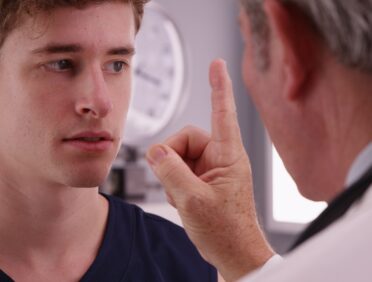Concussion Awareness Course FAQs is aimed at anyone who needs answer to concussion questions, concussion signs and symptoms, concussion prevention and safety.
A concussion is a type of traumatic brain injury (TBI) that occurs when the brain experiences a sudden jolt or impact, causing temporary dysfunction. It is typically caused by a blow to the head, but can also result from a strong force or shaking of the body.
The defining characteristic of a concussion is the alteration of brain function rather than structural damage. Unlike other types of brain injuries, such as skull fractures or bleeding in the brain, concussions do not typically show up on imaging tests like CT scans or MRIs.
Some common signs and symptoms of a concussion include:
- Headache or a feeling of pressure in the head.
- Temporary loss of consciousness.
- Confusion or feeling disoriented.
- Memory problems, including difficulty remembering the events leading up to the injury.
- Dizziness or balance issues.
- Nausea or vomiting.
- Fatigue or feeling drowsy.
- Sensitivity to light or noise.
- Changes in sleep patterns.
- Mood changes, such as increased irritability, anxiety, or depression.
It’s important to note that symptoms can vary widely and may not appear immediately after the injury. They can manifest within minutes, hours, or even days following the incident. It’s crucial to seek medical attention if you suspect a concussion, as a healthcare professional can evaluate the severity of the injury and provide appropriate guidance for recovery.
Why is concussion awareness important
Concussion awareness is crucial for several reasons:
Identification and Diagnosis: Awareness of the signs and symptoms of a concussion helps individuals and healthcare professionals identify and diagnose the injury accurately. Prompt recognition of a concussion allows for appropriate management and prevents further harm. Without awareness, concussions may go unnoticed or be attributed to less serious conditions, delaying necessary treatment.
Proper Management: Understanding concussions helps individuals, including athletes, coaches, parents, and teachers, implement appropriate management strategies. This includes physical and cognitive rest, gradually returning to activities, and taking necessary precautions to prevent further injury. Proper management can minimise the risk of complications and promote faster recovery.
Prevention: Awareness of concussions aids in implementing preventive measures to reduce the occurrence of these injuries. This includes educating individuals about safe sports techniques, using appropriate protective gear, maintaining a safe environment, and following guidelines for injury prevention. Increased awareness can help identify high-risk activities and situations where concussions are more likely to occur.
Long-Term Consequences: Concussions, if not managed properly, can have long-term consequences, such as prolonged symptoms, cognitive impairment, and increased susceptibility to future concussions. Understanding the potential risks and complications associated with concussions can motivate individuals to seek appropriate medical attention and follow the recommended recovery protocols.
Support and Education: Concussion awareness fosters a supportive environment for individuals who have experienced concussions. It promotes empathy, understanding, and appropriate accommodations to facilitate their recovery and successful reintegration into daily activities, including school, work, and sports.
Research and Advancements: Increased awareness of concussions drives research and advancements in the field. It helps prioritise funding for research, leading to a better understanding of concussions, improved diagnostic tools, and more effective treatments. This knowledge contributes to the overall well-being and safety of individuals at risk of concussions.
How can you reduce the risk of brain damage
Reducing the risk of brain damage involves adopting various preventive measures and safety practices. Here are some important strategies to consider:
Wear Protective Gear: When participating in activities that pose a risk of head injury, such as sports, cycling, or riding motorcycles, always wear appropriate protective gear. This includes helmets designed specifically for the activity, ensuring they fit properly and are in good condition.
Practise Safe Driving: Follow traffic rules, avoid distracted driving (e.g., using mobile phones), and always wear seat belts when driving or riding in a vehicle. Child safety seats should be used for young children. These precautions reduce the risk of severe head injuries in case of accidents.
Prevent Falls: Take steps to prevent falls, which are a leading cause of brain injuries, especially among older adults. Use handrails on stairs, install safety gates for young children, keep floors clear of clutter, use non-slip mats in the bathroom, and ensure adequate lighting in all areas.
Make Living Spaces Safe: Remove potential hazards from your living spaces, such as sharp or hard-edged furniture, that could increase the risk of head injuries during accidents or falls.
Practice Sports Safety: If you or your children participate in sports, follow proper safety protocols. This includes using appropriate protective equipment, following the rules of the game, and receiving proper training and coaching to prevent head injuries.
Avoid Shaking: Avoid shaking infants or young children vigorously, as this can cause severe brain damage. Shaking a baby can lead to shaken baby syndrome, which can result in serious brain injuries and even death.
Maintain a Healthy Lifestyle: A healthy lifestyle contributes to overall brain health. Engage in regular physical exercise, eat a balanced diet, get enough sleep, and manage stress effectively. Taking care of your overall well-being can reduce the risk of certain medical conditions that may contribute to brain damage, such as stroke or certain types of infections.
Promote Workplace Safety: Follow safety guidelines and use appropriate protective equipment in the workplace, especially in occupations that carry a higher risk of head injuries. Employers should provide training, safety protocols, and equipment necessary to minimise the risk of brain injuries.
Educate Yourself: Stay informed about the risks and precautions related to brain injuries. Be aware of potential hazards in your surroundings and seek guidance on safety measures specific to your activities and environment.
What are the main signs of concussion
The main signs of a concussion can vary from person to person, but there are common indicators to watch out for. One prominent sign is the presence of physical symptoms such as headaches, dizziness, or a feeling of pressure in the head. Individuals with a concussion may also experience sensitivity to light or noise, blurry vision, or difficulty with balance and coordination. Nausea, vomiting, and fatigue are additional physical signs that can manifest after a concussion.
In addition to physical symptoms, cognitive and emotional changes can occur. Memory problems, difficulty concentrating, and feeling mentally foggy or confused are common cognitive symptoms. Emotional signs may include irritability, increased anxiety, sadness, or mood swings. Sleep disturbances, such as insomnia or excessive drowsiness, can also be indicative of a concussion. It is important to note that these symptoms may not appear immediately after the injury and can develop over time, so it’s crucial to pay attention to any changes in one’s physical, cognitive, or emotional state following a head injury. If there is any suspicion of a concussion, seeking medical evaluation is advised for proper diagnosis and management.
Is a concussion bad for the brain
A concussion is considered a mild traumatic brain injury (TBI), and while it is typically not life-threatening, it is still important to take it seriously. While the effects of a concussion are usually temporary, it can still have negative implications for the brain. The brain undergoes rapid acceleration and deceleration during a concussion, which can cause a disruption in its normal functioning. This disruption can lead to a range of symptoms, such as headaches, dizziness, memory problems, and changes in mood or behaviour.
It is crucial to manage a concussion properly to minimise potential complications. If not managed appropriately, repeated concussions or returning to physical activity too soon after a concussion can increase the risk of more severe and long-lasting effects. Research has shown that repeated concussions or not allowing the brain to fully recover from a concussion can lead to a condition called chronic traumatic encephalopathy (CTE), which is a progressive degenerative brain disease associated with memory loss, cognitive impairment, and behavioural changes.
While most people recover fully from a single concussion with appropriate rest and care, it is important to seek medical attention and follow the recommended recovery protocols. This allows for proper monitoring, guidance, and support during the healing process to ensure the best possible outcomes for brain health.
How do doctors check for concussion
When evaluating a potential concussion, doctors employ a combination of methods to check for and diagnose the injury. The assessment typically involves a comprehensive evaluation of the individual’s symptoms, medical history, and a physical examination. During the examination, the doctor will assess various aspects, including neurological function, cognitive abilities, and balance.
The doctor will likely ask about the specific symptoms experienced, such as headaches, dizziness, memory problems, or changes in mood. They may also inquire about the circumstances surrounding the injury, the presence of any loss of consciousness, and the progression of symptoms since the incident. Gathering this information helps the doctor understand the individual’s unique situation and determine the likelihood of a concussion.
The physical examination may involve assessing vital signs, examining reflexes, coordination, and sensory responses. The doctor may also perform cognitive tests to assess memory, attention, concentration, and problem-solving abilities. Balance and coordination tests can help identify any impairments or abnormalities that may indicate a concussion.
In some cases, additional diagnostic tests may be recommended to rule out other potential causes of symptoms or to assess the severity of the injury. These tests may include neuroimaging scans like CT (computed tomography) or MRI (magnetic resonance imaging). However, it’s important to note that these imaging tests are usually performed to rule out more severe brain injuries, as concussions typically do not show structural damage on these scans.
Ultimately, the diagnosis of a concussion is primarily based on clinical evaluation and the individual’s reported symptoms. This comprehensive approach allows doctors to make an accurate diagnosis, provide appropriate guidance for management and recovery, and ensure the best possible care for the patient.
How long does a concussion last
The duration of a concussion can vary from person to person. While some individuals may recover within a few days or weeks, others may experience symptoms that persist for several weeks or even months. It is important to note that each concussion is unique, and factors such as the severity of the injury, individual differences, and adherence to proper management and rest can influence the duration of symptoms.
In general, the acute phase of a concussion, where symptoms are typically most pronounced, lasts for the first few days to a week after the injury. During this time, rest and avoiding activities that worsen symptoms are crucial for the brain to heal. As the days and weeks progress, most people begin to experience a gradual improvement in their symptoms.
However, some individuals may experience lingering symptoms, which is known as post-concussion syndrome (PCS). PCS is diagnosed when symptoms persist for more than three months after the initial injury. It is important for individuals experiencing prolonged symptoms to seek medical attention to ensure appropriate management and support.
Recovery from a concussion is highly individualised, and it is essential to listen to your body and give yourself the necessary time and care to heal. It is recommended to follow the guidance of a healthcare professional and gradually reintroduce activities as symptoms subside. Patience, rest, and proper management are key factors in promoting a full recovery.
What not to do with a concussion
When dealing with a concussion, it is important to be aware of what not to do in order to promote proper healing and avoid exacerbating symptoms. Firstly, it is crucial to avoid physically demanding activities that can put additional strain on the brain and potentially worsen the injury. Engaging in contact sports, vigorous exercise, or activities that carry a risk of falls should be avoided until cleared by a healthcare professional. Physical exertion can prolong recovery time and increase the likelihood of re-injury.
Secondly, it is essential not to ignore or downplay the symptoms associated with a concussion. Ignoring symptoms can lead to further complications and hinder the recovery process. It is important to listen to your body and take the necessary steps to rest and allow the brain to heal. Ignoring symptoms and pushing through daily activities can exacerbate symptoms, delay recovery, and potentially increase the risk of further injury. Seeking medical attention, following medical advice, and giving yourself adequate time to rest and recover are key aspects of concussion management.
How do you treat concussion
The treatment approach for a concussion typically involves a combination of physical and cognitive rest, symptom management, and gradual return to activity. Here are some key aspects of concussion treatment:
Rest: Physical and cognitive rest is crucial in the early stages of concussion treatment. This involves limiting activities that can strain the brain, such as sports, exercise, excessive screen time, and mentally demanding tasks. Resting allows the brain to heal and reduces the risk of exacerbating symptoms. It is important to follow the guidance of a healthcare professional regarding the duration and extent of rest needed.
Symptom Management: Medications are not typically prescribed for concussions, as they cannot directly heal the injury. However, over-the-counter pain relievers, such as acetaminophen, may be recommended to manage headache symptoms. It is important to avoid medications that can thin the blood, such as aspirin or ibuprofen, as they may increase the risk of bleeding in case of an undiagnosed brain injury. Resting in a quiet, dimly lit environment and using cold compresses on the head may help alleviate symptoms such as headaches or sensitivity to light and noise.
Gradual Return to Activity: Once symptoms start to improve, a gradual return to activity can be initiated under the guidance of a healthcare professional. This stepwise process involves gradually reintroducing physical and cognitive activities while monitoring for any recurrence or worsening of symptoms. The pace of return to activity is individualised and depends on the severity and duration of symptoms.
It is crucial to follow the treatment plan provided by a healthcare professional and attend any recommended follow-up appointments to ensure proper monitoring and support throughout the recovery process.
Who mostly gets concussions
Concussions can occur in people of all ages and across various demographics. However, certain groups are more commonly affected by concussions due to the nature of their activities or other factors. Sports-related concussions are particularly prevalent among athletes, with a higher incidence observed in contact sports such as football, hockey, rugby, and soccer. Athletes participating in these sports may experience collisions, falls, or impacts that can result in a concussion. Additionally, individuals involved in high-risk activities such as skateboarding, skiing, or biking may also be at a higher risk of experiencing concussions.
Furthermore, certain age groups are more susceptible to concussions. Children and adolescents are more prone to concussions due to their participation in sports and recreational activities, as well as their active and developing brains. Older adults, particularly those above the age of 65, are also at an increased risk of concussions due to factors like age-related balance issues, falls, and the potential for complications from head injuries.
While athletes, children, and older adults are commonly associated with concussions, it is important to remember that concussions can affect individuals from all walks of life. Accidents, falls, motor vehicle accidents, physical assaults, and workplace injuries can lead to concussions in anyone, regardless of age or occupation.
How long does it take to recover from a concussion
The recovery time for a concussion can vary widely from person to person. While some individuals may experience a relatively quick recovery within a few days or weeks, others may require a longer recovery period lasting several weeks or even months. The duration of recovery depends on several factors, including the severity of the concussion, individual differences, and adherence to proper management and rest.
In general, most people experience significant improvement in their symptoms within the first few weeks after the injury. The acute phase of a concussion, where symptoms are typically most pronounced, tends to resolve during this time. However, it is important to note that some individuals may experience lingering symptoms beyond the acute phase. If symptoms persist for more than three months, it is referred to as post-concussion syndrome (PCS).
Factors that can influence the duration of recovery include the age of the individual, previous history of concussions, overall health, and the presence of other medical conditions. It is essential to follow the guidance of a healthcare professional throughout the recovery process and to allow for adequate rest and gradual return to activities. Patience, proper management, and individualised care are key to promoting a full recovery from a concussion.
What does a concussion headache feel like
A concussion headache can vary in terms of intensity, duration, and specific characteristics from person to person. However, there are common features that are often associated with a concussion headache.
A concussion headache is typically described as a dull, throbbing, or pressure-like sensation in the head. It may feel like a tight band around the head or as if there is a weight or pressure inside the skull. The pain is commonly located in the forehead, temples, or back of the head, but it can also be felt throughout the entire head. The intensity of the headache can range from mild to severe and may fluctuate throughout the day.
In addition to the headache itself, individuals with a concussion may also experience other accompanying symptoms such as sensitivity to light and noise, dizziness, nausea, or difficulty concentrating. These symptoms can further contribute to the overall discomfort and impact of the concussion headache. It is important to note that each person’s experience with a concussion headache can be unique, and it is crucial to seek medical evaluation for proper diagnosis and appropriate management.
Why are concussions not taken seriously
While there has been progress in recent years, it is true that concussions have not always been taken as seriously as they should be. Several factors have contributed to this issue:
Lack of Awareness: In the past, there was a lack of widespread awareness about the potential seriousness and long-term consequences of concussions. People often regarded concussions as minor injuries that would resolve on their own without significant consequences. The lack of understanding about the potential impact of concussions led to a dismissive attitude and a failure to recognize the need for proper evaluation, treatment, and management.
Culture and Attitudes: In certain contexts, such as sports culture, there has historically been a focus on toughness and playing through injuries. This mindset, coupled with societal pressure to continue participating in activities despite potential injuries, has often resulted in concussions being downplayed or overlooked. This attitude has been changing gradually, with more emphasis placed on player safety and the recognition of the importance of properly addressing concussions.
Fortunately, increased research, public awareness campaigns, and evolving guidelines have helped shed light on the significance of concussions. It is now more widely recognized that concussions are a form of traumatic brain injury that require proper evaluation, rest, and management to ensure optimal recovery and prevent potential long-term consequences. Efforts are ongoing to continue raising awareness and promoting a shift in attitudes towards treating concussions with the seriousness they deserve.
Can a concussion change your life
Yes, a concussion has the potential to change an individual’s life, although the impact can vary from person to person. While most people recover fully from a single concussion with appropriate rest and care, some individuals may experience long-term effects that can significantly impact their daily life and overall well-being.
Post-Concussion Syndrome (PCS) is a condition that can arise after a concussion and involve persistent or recurring symptoms lasting beyond the expected recovery period. These symptoms may include chronic headaches, dizziness, difficulty concentrating, memory problems, fatigue, sleep disturbances, and mood changes. PCS can disrupt a person’s ability to perform daily activities, concentrate at work or school, maintain relationships, and engage in recreational pursuits. It can lead to a decreased quality of life, limitations in physical and cognitive functioning, and emotional challenges.
Furthermore, repeated concussions or inadequate recovery from a concussion can increase the risk of developing a condition called chronic traumatic encephalopathy (CTE). CTE is a degenerative brain disease associated with repetitive head trauma. It can cause significant cognitive decline, memory loss, mood disorders, behavioural changes, and other neurological symptoms that can have a profound impact on an individual’s life.
It is important to take concussions seriously, seek appropriate medical care, and adhere to proper management and recovery protocols to minimise the risk of long-term consequences.
Can concussions make you mentally ill
Concussions have the potential to contribute to mental health challenges, although it is important to note that they do not directly cause mental illness. Following a concussion, individuals may experience a range of cognitive, emotional, and behavioural changes that can impact their mental well-being. These changes can include difficulties with memory, concentration, emotional regulation, and overall mental functioning.
In some cases, the emotional and cognitive symptoms resulting from a concussion can resemble symptoms of certain mental health conditions such as depression, anxiety, or post-traumatic stress disorder (PTSD). However, it is essential to differentiate between the temporary effects of a concussion and a pre-existing or newly developed mental illness. It is not uncommon for individuals to experience emotional distress and changes in mood following a concussion, but these symptoms typically improve as the brain heals.
If an individual experiences persistent or worsening mental health symptoms after a concussion, it is important to seek appropriate medical attention for proper evaluation and diagnosis. Mental health professionals can provide the necessary support and interventions to address any mental health concerns that may arise in the aftermath of a concussion.
Do concussions show on MRI
Concussions typically do not show up on traditional MRI (magnetic resonance imaging) scans. MRI scans are primarily used to detect structural abnormalities in the brain, such as tumours, bleeding, or structural damage caused by severe traumatic brain injuries. However, concussions, being a mild form of traumatic brain injury, do not typically cause visible structural changes that can be detected by an MRI.
In some cases, more advanced imaging techniques such as diffusion tensor imaging (DTI) or functional MRI (fMRI) may be used to detect subtle changes in brain connectivity or activity associated with concussions. These techniques can provide insights into the functional and physiological alterations in the brain that may occur after a concussion. However, these imaging techniques are not routinely used in clinical practice for concussion diagnosis or management.
Instead, the diagnosis of a concussion is primarily based on clinical evaluation, including a thorough assessment of symptoms, medical history, and physical examination. Healthcare professionals rely on the reported symptoms and signs exhibited by the individual, as well as any history of head trauma, to make an accurate diagnosis and guide appropriate management and treatment.
Can anything make a concussion worse
Several factors and actions have the potential to worsen a concussion or prolong the recovery process. It is crucial to be aware of these factors and to take precautions to prevent further harm. Here are some key elements to consider:
Physical Exertion and Impact: Engaging in physical activities that can cause additional jolts or impacts to the head can worsen a concussion. It is essential to avoid participating in contact sports, high-risk activities, or anything that carries a risk of falls or blows to the head. Excessive physical exertion can strain the brain and delay healing.
Cognitive Overload: Mental strain, such as prolonged concentration, multitasking, or excessive screen time, can exacerbate symptoms and hinder recovery. It is important to give the brain adequate rest and limit mentally demanding activities that can overload cognitive function. Taking breaks and allowing the brain to recover can contribute to a smoother healing process.
Return to Activities Too Soon: Returning to regular activities, including work, school, or sports, too quickly after a concussion can be detrimental. It is crucial to follow the guidance of a healthcare professional and gradually reintroduce activities only when symptoms have significantly improved and with their approval. Returning to activities prematurely can prolong symptoms and increase the risk of re-injury.
Ignoring Symptoms: Disregarding or downplaying the symptoms of a concussion can lead to further complications and delay recovery. It is important to listen to your body and seek medical attention if you experience any symptoms or notice any changes in your physical or cognitive well-being. Ignoring symptoms can hinder the healing process and potentially increase the risk of more severe consequences.
Alcohol and Recreational Drugs: Consumption of alcohol or recreational drugs during the recovery period can impair judgement, interfere with healing, and potentially worsen symptoms. It is advisable to avoid these substances until fully recovered to ensure optimal healing and minimise potential complications.
By being aware of these factors and taking appropriate precautions, individuals can help protect their brains, promote healing, and facilitate a smoother recovery from a concussion.
What is the difference between a mild concussion and a severe concussion
The classification of a concussion as mild or severe is based on the severity of the symptoms and the duration of the associated impairments. While the terms “mild” and “severe” are used to describe the level of injury, it is important to note that even a mild concussion should be taken seriously and managed appropriately. Here are some distinctions between mild and severe concussions:
Mild Concussion: A mild concussion is typically characterised by relatively brief symptoms and a relatively quick recovery. Symptoms may include headache, dizziness, confusion, memory problems, and changes in mood or behaviour. Loss of consciousness, if present, is typically brief, lasting for seconds or minutes. In most cases, a person with a mild concussion can recover within a few days to a few weeks with appropriate rest and management. However, it is important to closely monitor symptoms and seek medical attention if symptoms worsen or persist.
Severe Concussion: A severe concussion involves more pronounced symptoms and longer-lasting impairments. Symptoms can include prolonged loss of consciousness, persistent confusion, significant memory problems, severe headaches, repeated vomiting, seizures, and even neurological deficits. Recovery from a severe concussion may take several weeks or months, and some individuals may experience long-term or permanent impairments. Severe concussions may require more extensive medical monitoring and interventions, and the recovery process may involve additional rehabilitation therapies.
It is important to note that the classification of a concussion as mild or severe is not solely based on the initial impact or force of the injury, but rather on the severity and duration of the symptoms and impairments that follow. It is always recommended to seek medical attention for a proper evaluation, diagnosis, and guidance on management, regardless of the perceived severity of the injury.
Do concussions get worse over time
Concussions do not typically get worse over time, but it is important to note that symptoms can evolve and change throughout the recovery process. While most symptoms tend to improve gradually, it is not uncommon for some individuals to experience temporary fluctuations in symptoms during their recovery. These fluctuations can be influenced by various factors, including physical activity, cognitive exertion, stress, and individual differences in healing.
In some cases, delayed onset of symptoms can occur, where symptoms may not appear immediately after the injury but instead develop over the course of hours or even days. This delayed onset can create the perception that the concussion is getting worse, when in reality, it is a natural progression of the symptoms. It is important to inform a healthcare professional if new or worsening symptoms arise, as they can assess the situation and provide appropriate guidance.
However, if symptoms worsen significantly or persistently over time, it may indicate a more serious underlying issue or complications. In such cases, seeking medical attention is essential to evaluate and address any potential concerns. Proper management, rest, and following medical advice can help ensure a smoother recovery and minimise the risk of complications.
What part of the head is most vulnerable
The part of the head that is most vulnerable to injury depends on the specific circumstances and mechanisms of impact. However, certain areas are generally considered to be more vulnerable to injury due to their anatomical characteristics and proximity to the brain.
The frontal region of the head, including the forehead and temples, is commonly susceptible to injury. This area is particularly vulnerable to direct blows or impacts, as it has less natural protection compared to other parts of the head. The forehead lacks significant bone coverage and relies mainly on the thickness of the scalp and soft tissues for protection. The temples are also relatively thin and house important blood vessels. Blows to these areas can transmit force to the underlying brain, potentially resulting in a concussion or other head injuries.
Additionally, the occipital region, located at the back of the head, is another vulnerable area. It is less protected by bone compared to the frontal region. Blows or impacts to the back of the head can result in whiplash-like movements, which can cause the brain to move forcefully within the skull. This movement can lead to a concussion or other types of head injuries.
Can minor concussions cause brain damage
While minor concussions are generally considered to be less severe compared to more significant traumatic brain injuries, they still have the potential to cause brain damage. Brain damage can occur even in cases where the injury is labelled as “minor.” Concussions result from the rapid movement or jolting of the brain within the skull, which can disrupt normal brain function. This disruption can lead to temporary changes in cognitive abilities, behaviour, and physical well-being.
Repetitive or untreated minor concussions can also have cumulative effects on the brain, increasing the risk of long-term complications. Research has shown that repeated concussions or not allowing the brain sufficient time to heal between injuries can lead to a condition known as chronic traumatic encephalopathy (CTE). CTE is a degenerative brain disease associated with memory loss, cognitive decline, mood disorders, and other neurological impairments.
It is important to take even minor concussions seriously, seek appropriate medical evaluation, and follow proper management protocols. By allowing the brain to rest and recover, individuals can minimise the risk of brain damage and promote a smoother recovery. Early detection and proper care are crucial in preventing potential long-term consequences associated with brain damage.
How can I test for a concussion at home
It is important to note that diagnosing a concussion should be left to healthcare professionals who have the necessary expertise and tools for accurate evaluation. While there are certain home assessments and tests that can provide some information, they cannot replace a comprehensive medical evaluation. However, if you suspect a concussion, you can consider the following steps:
Monitor Symptoms: Pay close attention to any symptoms you are experiencing and track their frequency, severity, and duration. Common symptoms include headaches, dizziness, memory problems, confusion, nausea, and changes in mood or behaviour. Tracking your symptoms can provide valuable information to share with a healthcare professional during a medical evaluation.
Rest and Observe: It is crucial to rest both physically and cognitively after a head injury. Avoid activities that can worsen symptoms, such as intense physical exertion, mentally demanding tasks, or exposure to bright lights and loud noises. Take note of any changes or developments in symptoms and communicate them to a healthcare professional during your evaluation.
Remember, self-diagnosis or relying solely on home assessments is not recommended. If you suspect a concussion, it is important to seek medical attention for a thorough evaluation and proper diagnosis.
Be Prepared: Concussion Awareness Training
Being prepared and knowledgeable about concussions is crucial for promoting safety and proper management. Concussion awareness training can provide individuals with valuable information and skills to identify, respond to, and manage concussions effectively. Here are a few key points about the importance of concussion awareness training:
Recognition and Early Intervention: Concussion awareness training equips individuals with the ability to recognize the signs and symptoms of a concussion promptly. This early recognition allows for immediate intervention, ensuring that appropriate medical evaluation and care can be sought as soon as possible. By being trained in concussion awareness, individuals can take proactive steps to prevent further injury and promote a faster recovery for those affected.
Safety and Prevention: Concussion awareness training educates individuals on preventive measures to reduce the risk of concussions. This includes understanding and following safety guidelines and proper techniques for various activities, such as sports or recreational pursuits. By promoting a culture of safety and prevention, concussion awareness training can help create safer environments and minimise the occurrence of concussions.
To download a .pdf of this blog, please click here












